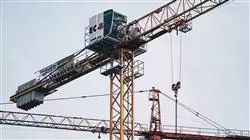University certificate
The world's largest faculty of engineering”
Introduction to the Program
A complete update on the advances and developments in the sector, in a high-level Postgraduate diploma"

The module, in addition to defining port planning and its historical evolution, develops the different port planning instruments required for the exercise of the profession specialized in port infrastructures.
The module is complemented, of course, with the contents of the State Ports Maritime Works Recommendations for port planning and includes the compilation of the up-to-date international regulations necessary for the design of maritime works globally.
The port planning and regulation module will provide the student with the ability to carry out the port infrastructure planning exercise and the regulatory tools for the design of
port infrastructures.
Port dredging is one of the most important engineering activities in the port sector, due to its magnitude and possible impacts.
This is why the professional dedicated to port infrastructures is required to have a wide knowledge of the materials to be dredged, as well as the proper selection of equipment, the fillings coming from such dredging, the dredging methodology and the different environmental considerations.
All these points are addressed in the dredging and pavement module in an efficient and practical way.
The preparation of the module is completed with the port pavements, an indispensable unit in almost every port action. The different standards for their design will also be discussed, including the latest Maritime Works Recommendations for the design and construction of pavements, ROM 4.1-18 and their comparison with other international standards such as those based on the British Standard.
During the execution of port infrastructure works, knowledge of the different specific work units, construction materials and the appropriate choice of machinery plays a
fundamental role.
This is why it is essential to plan the construction properly and always taking into account the different recommendations issued by official bodies such as State Ports and the experience of experts in the field, the module also develops the content of the Guide of Good Practices in the Execution of Maritime Works issued by that body.
A complete in-depth study of the most current criteria in the construction of port infrastructures"
This Postgraduate diploma in Postgraduate Diploma in Port Infrastructure Construction contains the most complete and up-to-date program on the market. The most important features include:
- The development of practical cases presented by experts in Port Infrastructures
- The graphic, schematic, and practical contents with which they are created provide scientific and practical information on the disciplines that are essential for
professional development - Practical exercises where self-assessment can be used to improve learning
- Its special emphasis on innovative methodologies in Port Infrastructures
- Theoretical lessons, questions to the expert, debate forums on controversial topics, and individual reflection assignments
- Content that is accessible from any fixed or portable device with an Internet connection
A quality program that will allow you not only to follow the specialization, but also to have complementary support and information banks available"
Its teaching staff includes professionals from the field of civil engineering, who contribute their work experience to this training, as well as renowned specialists from reference societies and prestigious universities.
The multimedia content, developed with the latest educational technology, will provide the professional with situated and contextual learning, i.e., a simulated environment that will provide immersive education that is programmed to teach students
in real situations.
This program is designed around Problem-Based Learning, whereby the professional must try to solve the different professional practice situations that arise throughout the Postgraduate diploma. For this purpose, the professional will be assisted by an innovative interactive video system developed by renowned and experienced experts in Port Infrastructures.
This program has the best educational resources that can be accessed online or downloaded, to make it easier for you to manage your studies and effort"

A very complete program, created with an objective focused on taking our students to the highest level of competence"
Why study at TECH?
TECH is the world’s largest online university. With an impressive catalog of more than 14,000 university programs available in 11 languages, it is positioned as a leader in employability, with a 99% job placement rate. In addition, it relies on an enormous faculty of more than 6,000 professors of the highest international renown.

Study at the world's largest online university and guarantee your professional success. The future starts at TECH”
The world’s best online university according to FORBES
The prestigious Forbes magazine, specialized in business and finance, has highlighted TECH as “the world's best online university” This is what they have recently stated in an article in their digital edition in which they echo the success story of this institution, “thanks to the academic offer it provides, the selection of its teaching staff, and an innovative learning method aimed at educating the professionals of the future”
A revolutionary study method, a cutting-edge faculty and a practical focus: the key to TECH's success.
The most complete study plans on the university scene
TECH offers the most complete study plans on the university scene, with syllabuses that cover fundamental concepts and, at the same time, the main scientific advances in their specific scientific areas. In addition, these programs are continuously being updated to guarantee students the academic vanguard and the most in-demand professional skills. In this way, the university's qualifications provide its graduates with a significant advantage to propel their careers to success.
TECH offers the most comprehensive and intensive study plans on the current university scene.
A world-class teaching staff
TECH's teaching staff is made up of more than 6,000 professors with the highest international recognition. Professors, researchers and top executives of multinational companies, including Isaiah Covington, performance coach of the Boston Celtics; Magda Romanska, principal investigator at Harvard MetaLAB; Ignacio Wistumba, chairman of the department of translational molecular pathology at MD Anderson Cancer Center; and D.W. Pine, creative director of TIME magazine, among others.
Internationally renowned experts, specialized in different branches of Health, Technology, Communication and Business, form part of the TECH faculty.
A unique learning method
TECH is the first university to use Relearning in all its programs. It is the best online learning methodology, accredited with international teaching quality certifications, provided by prestigious educational agencies. In addition, this disruptive educational model is complemented with the “Case Method”, thereby setting up a unique online teaching strategy. Innovative teaching resources are also implemented, including detailed videos, infographics and interactive summaries.
TECH combines Relearning and the Case Method in all its university programs to guarantee excellent theoretical and practical learning, studying whenever and wherever you want.
The world's largest online university
TECH is the world’s largest online university. We are the largest educational institution, with the best and widest online educational catalog, one hundred percent online and covering the vast majority of areas of knowledge. We offer a large selection of our own degrees and accredited online undergraduate and postgraduate degrees. In total, more than 14,000 university degrees, in eleven different languages, make us the largest educational largest in the world.
TECH has the world's most extensive catalog of academic and official programs, available in more than 11 languages.
Google Premier Partner
The American technology giant has awarded TECH the Google Google Premier Partner badge. This award, which is only available to 3% of the world's companies, highlights the efficient, flexible and tailored experience that this university provides to students. The recognition as a Google Premier Partner not only accredits the maximum rigor, performance and investment in TECH's digital infrastructures, but also places this university as one of the world's leading technology companies.
Google has positioned TECH in the top 3% of the world's most important technology companies by awarding it its Google Premier Partner badge.
The official online university of the NBA
TECH is the official online university of the NBA. Thanks to our agreement with the biggest league in basketball, we offer our students exclusive university programs, as well as a wide variety of educational resources focused on the business of the league and other areas of the sports industry. Each program is made up of a uniquely designed syllabus and features exceptional guest hosts: professionals with a distinguished sports background who will offer their expertise on the most relevant topics.
TECH has been selected by the NBA, the world's top basketball league, as its official online university.
The top-rated university by its students
Students have positioned TECH as the world's top-rated university on the main review websites, with a highest rating of 4.9 out of 5, obtained from more than 1,000 reviews. These results consolidate TECH as the benchmark university institution at an international level, reflecting the excellence and positive impact of its educational model.” reflecting the excellence and positive impact of its educational model.”
TECH is the world’s top-rated university by its students.
Leaders in employability
TECH has managed to become the leading university in employability. 99% of its students obtain jobs in the academic field they have studied, within one year of completing any of the university's programs. A similar number achieve immediate career enhancement. All this thanks to a study methodology that bases its effectiveness on the acquisition of practical skills, which are absolutely necessary for professional development.
99% of TECH graduates find a job within a year of completing their studies.
Postgraduate Diploma in Port Infrastructure Construction
.
Discover the Postgraduate Diploma in Port Infrastructure Construction program at TECH Global University and acquire the knowledge you need to excel in the exciting field of port engineering. Take advantage of our online classes and immerse yourself in a world of career opportunities. In an increasingly connected world, ports play a crucial role in international trade and the global economy. Our program will provide you with the skills and competencies to participate in the planning, design and construction of high-quality and efficient port infrastructure. With our online classes, you will be able to access world-class content from anywhere, anytime. Whether you are working on a current project or have personal commitments, you can adapt your study schedule to suit your convenience. Plus, you'll have the support of port engineering experts to guide you through the learning process.
Study port infrastructures in our Faculty of Engineering
.
In the Postgraduate Diploma, you will become familiar with the fundamental concepts of port engineering, including dock design, dredging management, terminal planning and port logistics optimization. You will learn best practices and state-of-the-art techniques to meet the specific challenges of this field. In addition, you will acquire knowledge in project management, economic and environmental feasibility analysis, and international regulations related to port infrastructure construction. These skills will enable you to tackle large-scale projects and contribute to the sustainable development of the ports of the future. At TECH Global University, we focus on the practical application of knowledge. Through real case studies and simulations, you will be able to put into practice the concepts learned and develop problem-solving skills in real port environments. This will give you the confidence to face complex challenges and make a difference in your career. Don't miss the opportunity to become an expert in port infrastructure construction. Enroll in TECH and get ready to propel your career to the next level.







